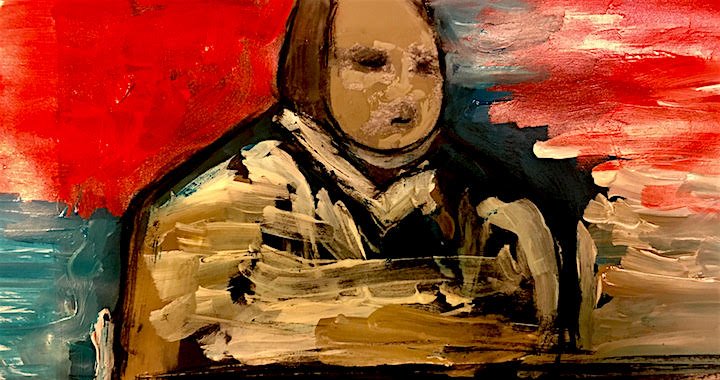
An AI-generated painting sold this year for 432,000 dollars. What do you think of this fact?
An AI-generated painting sold this year for 432,000 dollars
03/01/2018
In late October, Christie’s auction house in New York City witnessed an unprecedented event whose significance we may only truly understand in the future. To wit, for the first time ever, an AI-generated painting was sold at auction. Portrait of Edmond Belamy, painted by the GAN algorithm developed by the Paris-based collective Obvious, was sold for USD 432,000 – more than 40 times the expected price of USD 7000–10,000. Arterritory asked respondents to try to comment on what this event might mean for the future of art and how it could affect the art market.
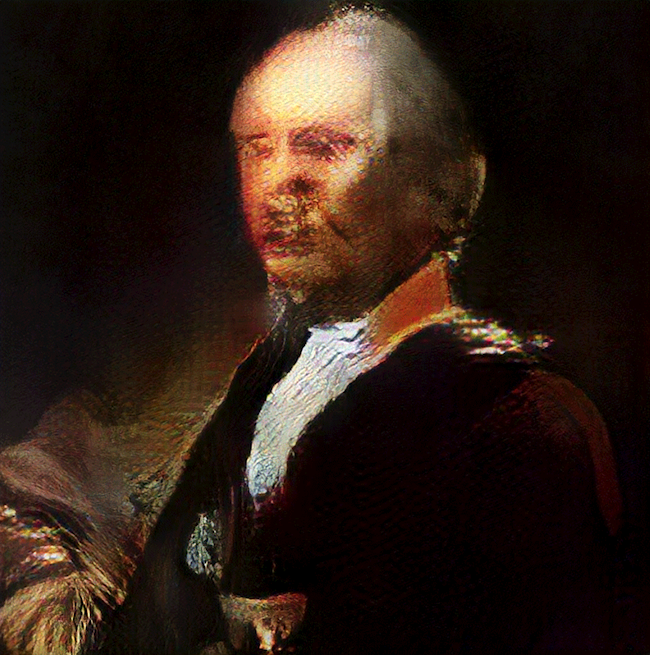
Obvious. Le Baron De Belamy. © Obvious, 2018
Joseph Kouli
art collector
Does AI stands for Artificial Idiocy? Idiocy has no limit.
Viktor Misiano, curator and Editor-in-Chief of the Moscow Art Magazine (Moscow)
Not a thing! The market has never been (and especially isn’t now) connected to the process of art.
Milena Orlova, art critic, Editor-in-Chief of The Art Newspaper Russia (Moscow)
Since childhood I’ve been fascinated by films about robots that shortly were going to replace people. Many years have passed since then but there are still not any robots around me. But speaking seriously, I do not believe in AI as a creative force, perhaps only because I am rather unfamiliar with it. Therefore, the fact that some dull portrait is sold in the auction for a big sum of money I take as an accident or an advertising move to promote new technologies. Anyway, all the art forgers can rejoice – they’ve got now a whole lot of new opportunities.
Gil Bronner
art collector
There is obviously too much money in the market!
I cannot believe that someone bought the work because of its sheer beauty and rarity; it’s more likely that they bought it for speculation. Good luck with that.
James Beckett
artist
Sheesh. That just feels retarded - in terms of a conversation on authorship, technology and the market in any case. But then I think of the support for the teams which further develop AI and find it a good investment. See the documentaries on Deep Blue and Watson as IBM conquers the human nuances of both chess and Jeopardy. Check out the perhaps more real work of Jonas Lund, and the recent show of Pierre Huyghe in the Serpentine, if AI is your cup of tea.
Zane Onckule
Programme Director at kim? Contemporary Art Centre
It’s fantastic! Although the ‘cult of the body’ is, on one hand, maintained through the the help of the beauty-, fashion-, and countless eco-industries, it is more like decoration or image projection. The real reality is definitely one that is non-tangible. It will be interesting to see if this ‘intelligence’ will receive its due earnings, and if so, how it will spend it.
Māris Vītols
curator and collector, head of the association “Latvijas kultūras projekti”
The use of computing machines in the creation of art, with the help of various algorithms, is becoming increasingly widespread. The cat has been out of the bag for several years now – in curatorial practice, the promotion of numerous projects that use artificial intelligence across a wide range of artistic fields can be said to be a notable trend. The 2017 Vienna Biennale was devoted to this phenomenon, at which, incidentally, they showed a robot created for the purpose of generating poetry. A month ago, the Japanese car manufacturer Lexus presented an advertising video for which the plot had been completely generated by AI. The sale of a painting made by AI at Christie’s means only that the art market has fully legitimised artwork that has been created in this way. Creative people should not be particularly concerned about this, as research shows that the profession of artist – along with that of, for example, a politician – is one the least exposed to the risk of extinction over the course of general robotization.
Līna Birzaka-Priekule
curator
On the one hand, it is a sign of the times – both the interest to do something like that and the amount of money that someone was willing to pay for it. However, the selling of the Edmond de Belamy portrait raises the question of – to what extent is the desire to make something technically feasible (and to be the first to do it) nothing more than a competitive discipline? And why is someone willing to pay such huge amounts for it? The critic Jerry Saltz wrote a very engaging article titled How Does the World Live With Itself?, which discusses the 2018 documentary film The Price of Everything.
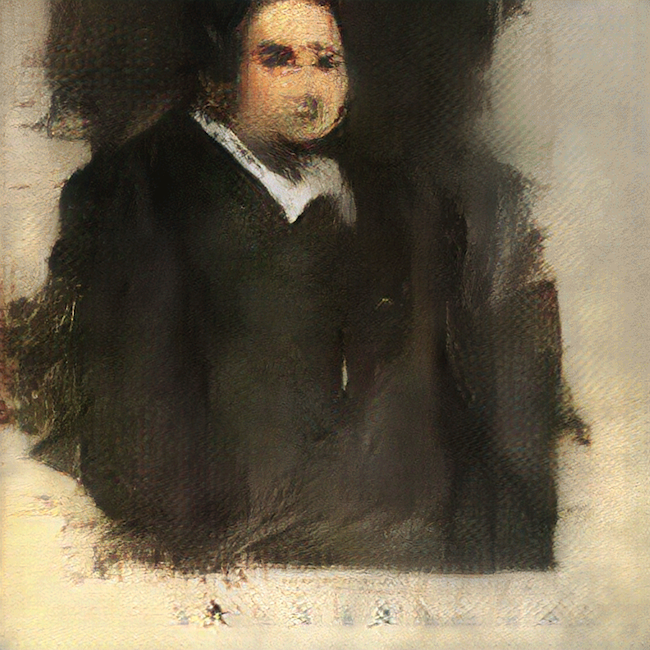
Obvious. Edmond de Belamy. © Obvious, 2018
Ivars Drulle
artist
Although this particular case is a most successful marketing and advertising trick, we must admit that artificial intelligence is rapidly entering our everyday lives. 20 years have passed since the first computer beat the reigning world champion at chess. Since then, computers have been growing faster and more creative, and over the past few years they have increasingly beat human champions at various different games. The year 2018 was remarkable in this field in that a game-playing AI beat the world’s fastest chess-playing computer program. In this case, it is important to note that before playing against the computer program, the AI was only given the rules of the game and it then taught itself how to play, all in under four hours.
I believe that the entry of artificial intelligence into the art field is comparable to that of art being infiltrated by photography, video and the internet. In other words, these extensions of human thoughts and hands have fundamentally changed the language of artwork.
I've read that there is a way that chess- or other professional game-players can recognise whether a game has been played by a human or an AI device. AI occasionally carries out moves that are seemingly illogical and that a human would never do. AI moves are not based on intuition, foresight or apprehension. Precisely because of the fact that AI completes its tasks outside the realm of human thought processes, it will also be able to enhance the element of surprise in artwork. AI machines will be able to move our creativity to such expanses that we cannot even imagine it. Artists will certainly be helped by using equipment that will, in relation to an artwork, act in a way that humans had not been able to imagine up to that point.
Vita Liberte
founder of the VV Foundation and a patron of the arts
Since I personally much more highly value an artist's intentions and ideas than their technical mastery, I would not buy such an artwork even at a hundredth of that price. However, it must be acknowledged that in the future, artificial intelligence could play a major role in art – just as it already has in other industries; the sooner artists integrate it into their processes, the better off they’ll be. Let's not forget what Warhol's particular technique of silk screening brought to the art world.
Karina Vissonova
design researcher and innovation strategist
First of all, this does not surprise me. I think that the value of this work of art is to be found in its historical significance as a symbol of societal and technological development. In my mind, this is, of course, just one of several factors. Another factor that I think could have affected such a high price is the buyer’s image. I assume that the buyer (as well as the other high bidders) is personally interested in AI technology – perhaps even more than in art.
In any case, the artistic value of this work does not affect me because the process that created this work was purely an analysis of a defined style of image production (at least that’s how I understand it from the surrounding press).
I am currently writing an essay for a publication on biomimicry, in which I discuss the qualities that define us as ‘human’ – and creativity is not a quality that sets us apart from other creatures. Both birds and fish show creative qualities in the way that they decorate their nests and territories. It is currently very fashionable to try defining what being ‘human’ entails because of the social humanoid robot Sophia, who, thanks to artificial intelligence, illustrates what a ‘human’ is but without quite all of the necessary qualities.
For example, if Sophia chose to engage in artistic activity and began to ‘paint’, would the value of her artwork be comparable to that of human-made artworks? Is Sofia considered to have an advantage due to the much larger amount of information available to a robot compared to a human being, which therefore surely affects the quality of the artwork created by the robot? Or does the human have the advantage because of our inherent imperfection, which leads to creating artworks not by analysing information, but rather by partly striving towards an imagined visual execution and partly by submitting to the physical qualities of the material/medium and any consequential mistakes, thereby ultimately leading to a work that we, as humans, can appreciate (precisely because we are imperfect...and perhaps that is where our value lies)?
I think that we have not yet introduced the correct language to adequately define this ‘novelty’. In any case, it is very interesting to discuss this issue from a philosophical point of view.
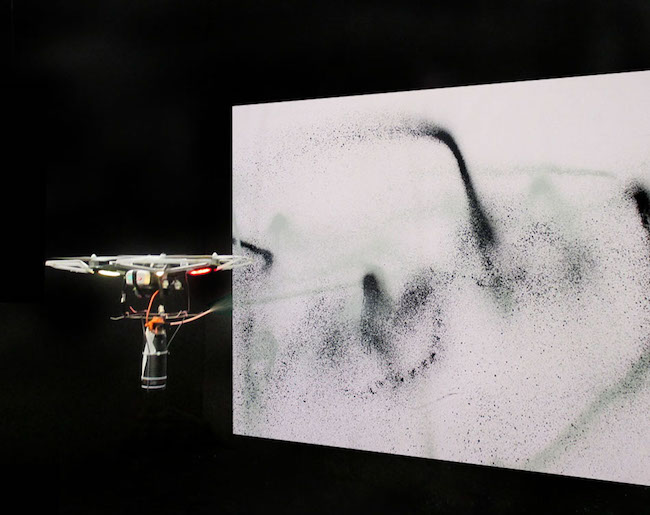
The work of the American artist KATSU - the paintings are created by drones. Photo: THE HOLE NYC
Artūrs Analts
designer
This is a post-apocalyptic message, in a sense: art will continue to live after the demise of humans. One must understand that artificial intelligence does not really create the painting itself. For now, a person asks questions and the AI answers – it is an interaction between humans and technology. This is one of the new technologies that, in the near future, will be increasingly applied and developed in terms of art. The work of the American artist KATSU is conceptually clever – the works are autonomous: the presence of a human being is removed from the process of creation as the paintings are created by drones.
Valentin Dyakonov
curator, the Garage Museum of Contemporary Art (Moscow)
It usually saddens me when the masterpieces are sold to the private collectors: the artwork flashes for a second and then disappears. In this case I am happy that this piece generated by the group of programmers is not going to be a part of any museum collection but will adorn somebody’s flat. I hope we shall never see it again.
Marko Mäetamm
artist
To use artificial intelligence to make art, generate music, write texts etc - there is nothing to be so surprised these days. We have cars that can ride without a driver, planes that can fly without a pilot and I believe this is only a beginning. The algorithm the painting was generated by was made by somebody and turned into a medium for making art. Years ago photography became a medium for making art, then video became a medium for making art, then computer became a medium for making art. I like to see all these mediums - photography, video, computer as extensions of our hand, or even an artificial hand. Algorithm to me is just like a very-very-very long artificial hand but it still is somebodies hand. So I still can’t look at this painting as something created by a 100% not a human being.
To buy that piece for 432,000 dollars… it is a question of taste of course. I wouldn’t buy it because I like when I can feel the real person with the real soul and the real unique voice standing behind the work. Art for me is first of all human-to-human thing. But I think it was a good act to draw attention and make us to ask questions about what is going on and where art is going. But also to generate news and trigger broader debates. Just like when Elon Musk sent his Tesla car into Space.
Or - maybe all these things are just huge media manipulations and advertising campaignes. We live in a very interesting time.
Agniya Mirgorodskaya
Commissioner of the Riga International Biennial of Contemporary Art (RIBOCA)
It really scares me. For me art is an agent of self-expression, and that makes it enchanting. I am really worried about increasing role of technology in our lives, that it has already become inseparable part of us. I really wish we may preserve as much human ‘world’ as possible.
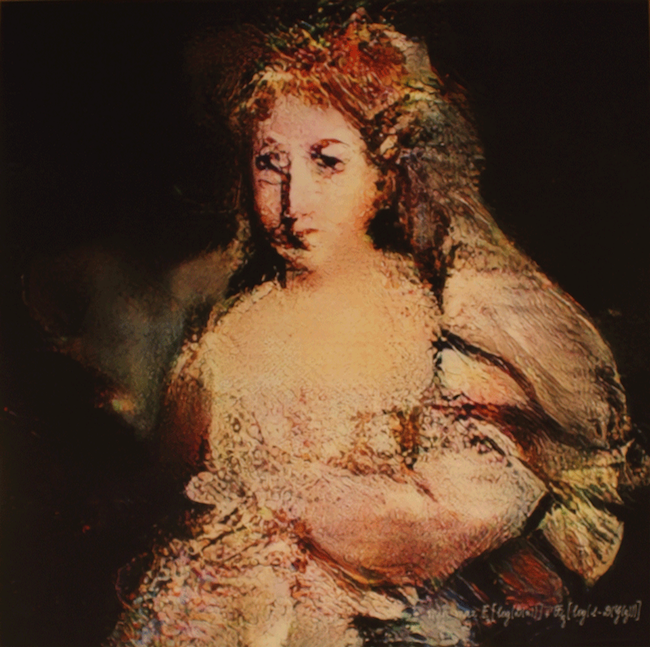
Obvious. La Comtesse De Belamy. © Obvious, 2018
Natalia Serkova
art theorist, co-founder of the TZVETNIK project (Moscow)
I can’t really assess this fact in any particular way. It doesn’t add anything to the existing art market as itself. The market doesn’t do constant selling and buying of artists and their works, these are just empty shells filled up with new content every now and then; and AI replacing the artist doesn’t change anything in this system of shell filling. I’m sure that should not concern artists either. The niche of machine generated art will find its place in a line of other medium specific trends like paintings by elephants, art brut or science art. Like in any other specific art, the interest in AI art will rise and fall. I don’t think we need to talk about any post-human issues here or mention Blade Runner, because the art is still a product primarily created by humans to other humans.
Alisa Savitskaya
curator of the Volga‒Vyatka branch of the National Centre for Contemporary Art (Nizhny Novgorod)
The artwork itself is rather mediocre, the technology doesn’t compensate for the low quality. Yet the fact itself is curious, and one can regard it very differently. I tend to be a reserved optimist: nowadays the art cannot invent technology – this area is rather complex and expensive – therefore, the fact of technology getting in the territory of art, reinforced by the success of the first sale, one can perceive as rather positive occurrence. It’s too early to speak about ‘revolt of the machines’, however advanced technologies may offer artists new opportunities and tools.
Olga Temnikova
gallerist
It’s hard to say anything encouraging about it in the context of endless auction records, rarely the wisest and often so incidental. When the first countries exchange their parliaments for AI that will be worthwhile, I guess.
Stepan Subbotin
member of the ZIP art group (Krasnodar)
Seems like I have missed this fact, however I think the artists and machines should work in creative collaboration. I am happy for AI.
+++pagesplit+++